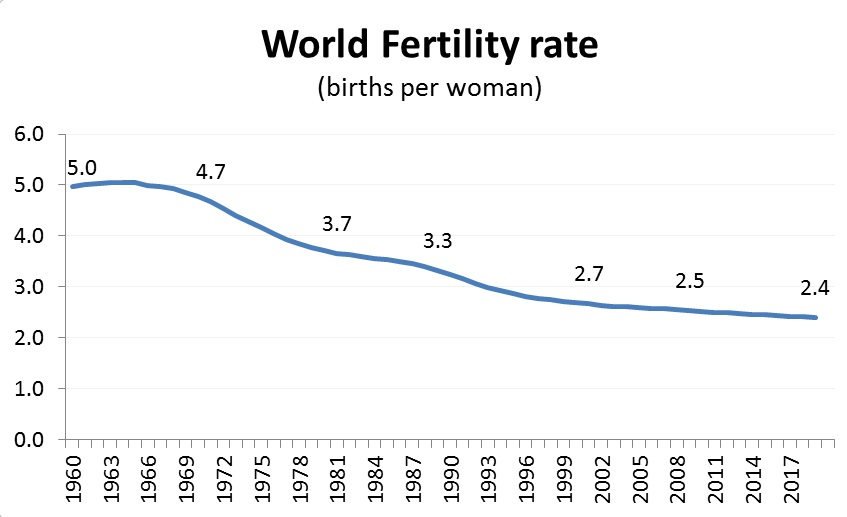
We often hear about over-population, and many of us feel it through ever growing population in our big cities, immigration, and increasing real estate prices driven by more and more people pursuing fewer and fewer homes. Are there too many of us?
Certainly world’s population and population of many developed countries continues to grow. However, you may be surprised that it is growing at a decreasing rate and the declining trend has been there for years. We are now passing the 1% growth mark but it is certain that the rate is to decline further.
What are the two key variables of world population growth – 1) fertility rate measured by the number of kids per woman and 2) increase in expected life span. While longevity is hugely important for particular individuals, it has a somewhat temporary effect as life span tends to level off when country’s life expectancy reaches low 80s. In addition, retired individuals have a relatively low effect on economic growth as most stop working and consume less.
With this in mind, fertility rate becomes the primary metric that defines long term population growth. Let’s take a look at world’s fertility rate.

As you can see the trend is declining. While in 1960, women had 5 kids on average per woman, it is only 2.4 now. The sustainable birth rate is 2.1 babies per woman – this insures population growth is essentially 0 (the additional 0.1 is a reflection of some infants dying during birth). So we are getting close to this figure. Once below, the population will start declining. In fact, Elon Musk considers the population decline as one of the key threats to the long term survival of our species.
It is a known fact that most of the population growth and babies are in the developing countries. In fact, it seems that generally women in poorer, less developed countries tend to have more kids. Research has shown that this may have to do with the general level of women’s education. There are more highly educated women in developed nations that pursue careers, taking time away from having more babies. Of course, there are many examples of highly successful career-oriented women who also have many children but those mothers are extra-ordinary. A day does have only 24 hours, and the little ones do require a lot of time.
Let’s look at the G20 countries demographics, specifically focusing on the following 3 metrics: 1) fertility rate, 2) population growth, 3) a proportion of population with kids 0-14 years of age. The below table is essentially a demographics scorecard.
We generally indicate a positive value of the metric in green. In yellow, the metric is concerning. In red, things are really negative.
For birth rate (fertility rate), any value above 2 was marked green. Between 1.5-2 in yellow and below 1.5 in red. South Korea scores really low on the this metric. In fact, South Korean women have less than 1 baby on average, which is essentially a demographics time bomb in the making. Canada is another surprising member of the low birth rate list with just 1.47 kids per women despite high population growth rate.
China, US, UK, Germany and Russia all have low fertility below the sustainable birth rates. South Africa, Saudi Arabia, Argentina, Indonesia and India have positive fertility rates. Interestingly, India world’s second most populace country has this rate rapidly declining and potentially permanently hitting below 2.1 as a result of covid epidemic.
Population growth rates (average over the last 5 years) below zero, i.e. declines, were marked in red; below 1% in yellow and above 1% in green. The story here is very similar to the fertility rate – no wonder, population growth is a trailing indicator and as mentioned before, is driven by birth rate and growth in life expectancy. The other factor influencing population growth is immigration, and that is why both Canada and Australia, countries with high immigration, score positive on this metric despite low fertility rates and virtually maxing out on their citizens life span.
Proportion of population between 0 and 14, i.e. population of kids, very much follows the same pattern. Again this is a trailing indicator to a recent fertility rate (although there is a bit of a lag).
In Summary: World population is set to decline
In summary, we still see world population growing albeit at a decreasing pace and sooner or later, it will start declining. The primary cause of this is falling birth rate among women, especially in more developed countries. As frontier market economies develop, we are likely to see even further declines in the world fertility rate and ultimately a world population decline.
Developed economies populations will continue to grow for the foreseeable future solely because of immigration. The pace of growth will also be low as there is only so much immigration, a country can absorb.
Population Effect on Economic Growth and Markets
Population growth is one of the key drivers of the long term economic growth (the other being technological progress). With population growth in doubt, the pace of economic growth is also bound to decrease. This should also have an effect on stock market growth, which we predict to slow down given aging and soon-to-be declining populations. Fewer consumers = fewer profits. Fewer people = fewer workers = lower economic output.
Have more babies 🙂
